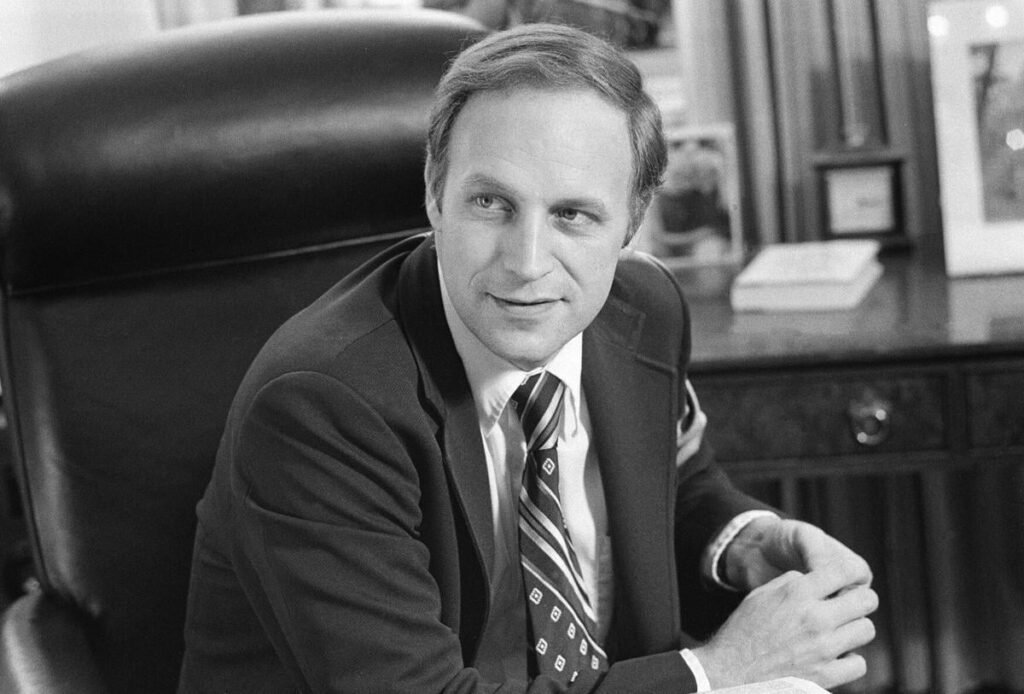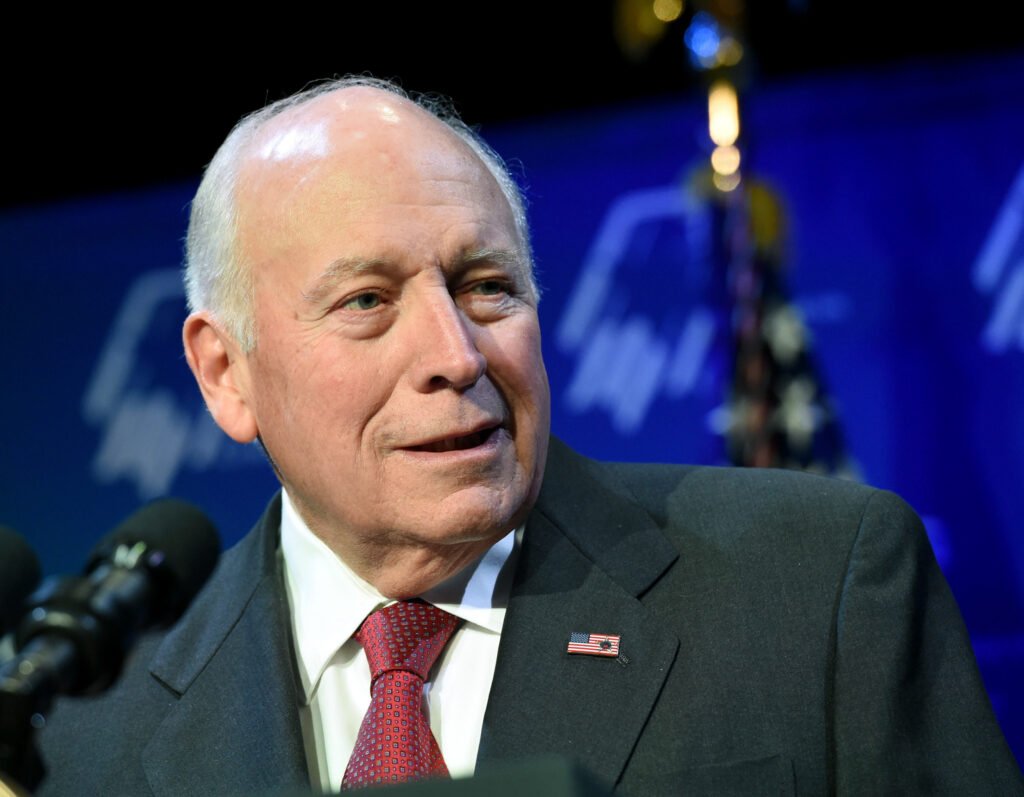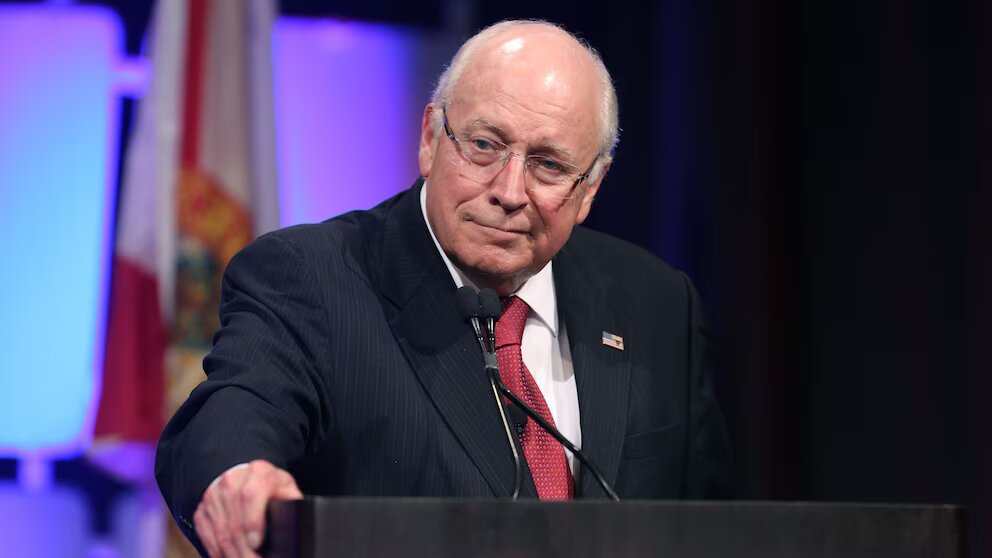Dick Cheney Then and Now
Dick Cheney Then
Dick Cheney, born Richard Bruce Cheney on January 30, 1941, in Lincoln, Nebraska, had a formative upbringing in Casper, Wyoming.
He was raised in a close-knit family alongside his mother, Marjorie; his father, Richard, who worked as a soil conservation agent for the U.S. Department of Agriculture; and his two younger siblings, Bob and Susan.
His mother was known for her athletic prowess, having been a successful softball player in the 1930s.
This environment, characterized by a strong work ethic and community involvement, likely influenced Cheney’s later ambitions and drive in both his personal and political life.
Cheney’s early education took place in Lincoln, where he attended College View Elementary School (now known as Calvert Elementary School) before moving to Casper, where he graduated from Natrona County High School.
There, he distinguished himself as senior class president and captain of the football team, demonstrating leadership qualities and a competitive spirit that would follow him into his political career.
After high school, Cheney briefly attended Yale University but left after less than two years due to poor academic performance, a decision that marked a challenging period in his early adult life.

Following his departure from Yale, he faced legal issues, being arrested twice for driving while intoxicated in the early 1960s.
Despite these setbacks, Cheney redirected his focus toward education and ultimately graduated from the University of Wyoming with both a Bachelor of Arts and a Master of Arts in political science.
His academic pursuits reflected a deepening interest in governance and policy, essential foundations for his future career.
He briefly pursued a doctorate at the University of Wisconsin–Madison but decided to leave the program in 1966 to accept a position as a staff aide to Governor Warren Knowles.
This decision marked the beginning of Cheney’s political trajectory, as he gained valuable experience and insights into state governance that would later inform his roles in the federal government.
Related Article: Al Gore Then and Now
Dick Cheney’s Political Career
Dick Cheney’s political career began to take shape in the late 1960s when he was awarded a congressional fellowship by the American Political Science Association in 1968.
This opportunity allowed him to move to Washington, D.C., where he served as an intern for Congressman William Steiger.
This early experience in Congress provided Cheney with invaluable insights into the legislative process and the inner workings of government.
From 1969 to 1970, he worked under Donald Rumsfeld in the Office of Economic Opportunity, further solidifying his connections within the Republican Party.
Related Article: Jimmy Carter Then and Now
Over the following years, Cheney held various positions, including White House Staff Assistant and Assistant Director of the Cost of Living Council, which laid the groundwork for his subsequent roles in the Ford administration.
Notably, Cheney served as Deputy Assistant to President Gerald Ford before ascending to the position of White House Chief of Staff, where he played a crucial role in managing the administration’s operations.
In 1978, Cheney transitioned from the executive branch to the legislative branch when he was elected to the U.S. House of Representatives, representing Wyoming.
His tenure in Congress was marked by significant achievements, as he was re-elected five times and held leadership positions, including Chairman of the House Republican Policy Committee from 1981 to 1987.
Related Article: George W. Bush Then and Now
In 1988, he was elected House Minority Whip, a role that showcased his growing influence within the party.
However, in 1989, Cheney departed from the House to serve as Secretary of Defense under President George W. Bush.
His time as Secretary was pivotal, as he directed military operations during crucial campaigns, such as Operation Just Cause in Panama and Operation Desert Storm in the Gulf War.
His leadership in these conflicts earned him accolades, including the Presidential Medal of Freedom and the U.S. Senator John Heinz Award for Greatest Public Service.
Related Article: Bill Clinton Then and Now
Cheney’s political career reached new heights when he was elected Vice President under George W. Bush, serving from 2001 to 2009.
During this period, he was known for his assertive and sometimes controversial influence on White House policy, particularly in the realms of foreign affairs and national security.
Cheney played a critical role in shaping the administration’s response to the events of September 11, 2001, and was a vocal proponent of the “War on Terror.”
Related Article: Michelle Obama Then and Now

His assertions that Iraq possessed weapons of mass destruction and had links to terrorist groups like Al Qaeda significantly impacted U.S. foreign policy and led to the invasion of Iraq in 2003.
Cheney’s vice presidency was marked by his assumption of presidential powers during President Bush’s medical procedures, highlighting his substantial role in the administration.
However, Cheney’s time in office was not without controversy. He faced considerable criticism for endorsing the administration’s “enhanced interrogation techniques,” which included waterboarding, and his approval ratings plummeted, hitting a low of 13% by the end of his term.
Related Article: Jeff Flake Then and Now
Following the Bush administration, Cheney retreated from public life but continued to influence political discourse through his writings, including two books co-authored with his daughter Liz.
His personal health challenges, including a heart transplant in 2012 after multiple heart attacks, were significant chapters in his life post-office, demonstrating resilience and a continued engagement with public life despite his health struggles.
Cheney’s political career remains a subject of extensive analysis and debate, reflecting his profound impact on American politics and foreign policy in the late 20th and early 21st centuries.
Related Article: John Hickenlooper Then and Now
Dick Cheney’s Wife and Children
On August 29, 1964, Dick Cheney married Lynne Vincent, a partnership that would not only be a personal cornerstone for Cheney but also a significant aspect of his public persona.
Lynne, who later became known as Lynne Cheney, is an accomplished author and former Second Lady of the United States.
The couple welcomed two daughters into their family: Elizabeth, often referred to as Liz and Mary.
Related Article: Larry Hogan Then and Now
Throughout Cheney’s extensive political career, Lynne has been a steadfast supporter, often engaging in public life alongside him.
Their daughters have also played prominent roles in American political discourse, with Liz Cheney notably serving as a U.S. Representative from Wyoming and becoming a vocal critic of some aspects of Donald Trump’s presidency.
The Cheney family’s close-knit bond and shared commitment to public service have been a defining feature of their lives, influencing their individual paths and contributing to the family’s legacy in American politics.
Related Article: Tom Wolf Then and Now
Dick Cheney Now

At 83 years old, Dick Cheney stands as a prominent figure in American political history, having served as the 46th Vice President of the United States from 2001 to 2009.
His tenure is often characterized by significant events and decisions that have left a lasting impact on the nation, particularly in the realm of foreign policy and national security.
Cheney has been referred to as the most powerful vice president in American history, a title that underscores his influential role within the George W. Bush administration.
Related Article: Sheldon Whitehouse Then and Now
His strategic decision-making during pivotal moments, such as the response to the September 11 attacks, bolstered his prominence in Washington, where his peak approval rating soared to 68 percent in the aftermath of the attacks.
However, this approval was not to last, as his popularity waned, culminating in an approval rating of just 13 percent by the end of his vice presidency.
Since leaving office, Cheney has maintained a public profile, often speaking out about his views on the direction of the Republican Party.
Related Article: Ron Wyden Then and Now
His criticisms of modern Republican leadership have drawn attention, particularly regarding the influence of former President Donald Trump.
Cheney’s political stance has evolved to the point where he openly endorsed Trump’s challenger in the 2024 election, Democrat Kamala Harris, highlighting a significant rift within the party.
Related Article: Henry McMaster Then and Now
This endorsement reflects Cheney’s belief in the need for a return to traditional conservative values and governance, which he perceives as being undermined by the populist tendencies that have emerged in recent years.
Despite his controversial legacy, Cheney’s continued involvement in political discourse serves as a reminder of his enduring influence and the complex dynamics of American politics in the 21st century.
Related Article: Janet Mills Then and Now
Dick Cheney Net Worth
Dick Cheney, an American politician, author, and business executive, has amassed a substantial net worth estimated at $150 million, reflecting his extensive career in both public service and the private sector.
Related Article: Liz Cheney Then and Now






























